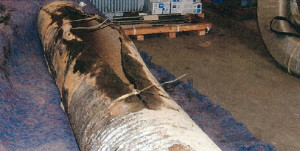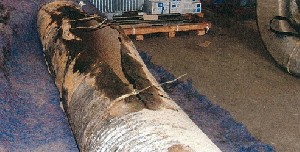Around 7:20 pm, at the time of injecting naphtha originating from a refinery, a steel pipeline (DN 500-62 bar: 7 mm thick) burst open at a site dedicated to underground hydrocarbon storage using saline cavities in the heart of the Luberon Natural Park. A deafening sound combined with a sudden drop in pressure caught the attention of employees. Some 400 m3 of naphtha flowed through the opening towards a 5,000-m3 capacity retention basin located several hundred metres downstream; from this basin, a total of 200 m³ of product spilled out via 2 sluice gates that had remained open and that would only be closed 27 minutes later.
The internal emergency plan was activated around 7:30 pm. Site personnel were evacuated, and the attendant fell ill and had to be hospitalised.
Faced with the risk of igniting a flammable cloud that had formed along the naphtha path, the local prefecture convened the emergency response unit and initiated the external emergency plan at 10 pm; 75 fire-fighters, a chemical emergency squad, another specialised pollution cleanup team and some 20 gendarme were all deployed. A 1,000-metre safety perimeter was implemented, traffic in the vicinity was closed on two thoroughfares, and 282 residents from two localities were evacuated. Rescue workers spread a foam blanket over the surface of the liquid contained in the retention basin and installed water curtains to dissipate the cloud. Two fire-fighters feel unwell and placed under oxygen assistance.
Four containment booms were installed on the AUSSELET and LARGUE streams, both of which were heavily impacted over a 5-km length. By 4 am the following morning, the majority of residents had returned to their homes, though water pumping was suspended in three nearby municipalities.
A specialised subcontractor pumped 150 m³ of the naphtha. Once the cloud had been dispersed, the external emergency plan was lifted at 6 pm the same day, and the last few evacuees were allowed to return home.
The land area surrounding the defective pipeline buried 2 m deep was excavated; a 3-m long opening was identified on the lower generatrix between 2 girth welds. The facility connecting the pumping station with the storage well, retested and certified in 2003 at 73 bar, was equipped with cathodic protection.
Impacts on flora and fauna were observed in pristine and protected natural sites (death of mammals, amphibians and invertebrates); an assessment was subsequently conducted (fauna, flora, water, sediments, soil/subsoil, ecotoxicity and genotoxicity), accompanied by enhanced monitoring of both surface water and groundwater resources.
An appraisal of the defective pipe segment revealed a “cavernous” type of corrosion (i.e. by differential aeration) that had become widespread over a 50-mm strip, with a loss of thickness (1 mm on average and in excess of 3.5 mm locally).
The operator devised an initial series of remedial measures to treat the recorded malfunctions, involving: remote automation of the sluice gates slaved to pressure drop detectors ,with relays to the control room and hydrocarbon detector servo systems; modification of pipe section shutoff equipment in the event of a leak; additional hydrocarbon detectors; inspection of sluice gate condition and seals.
Download the detailed report in .pdf format (315 Kb)





